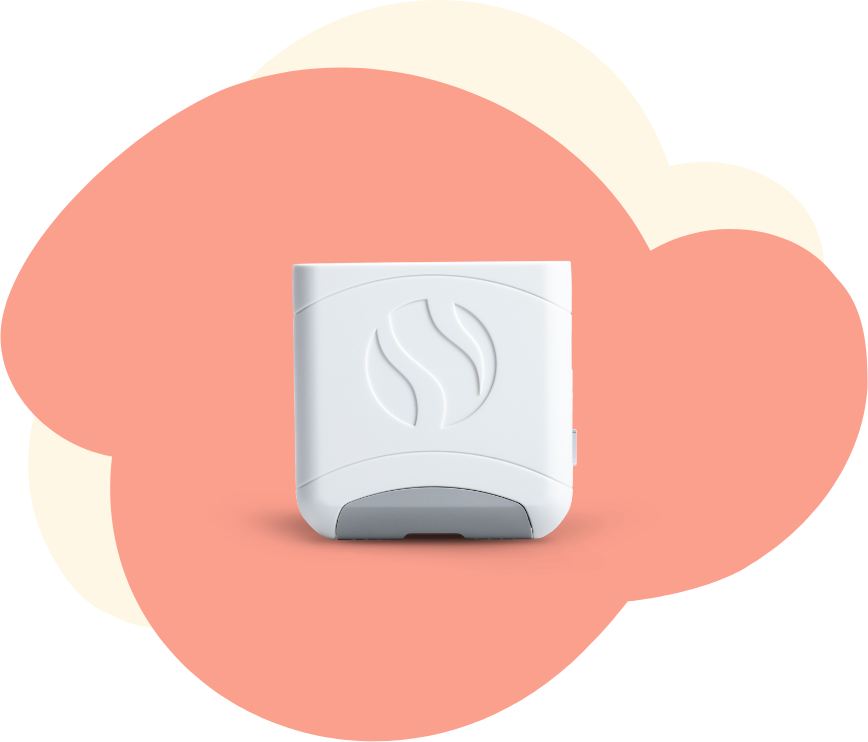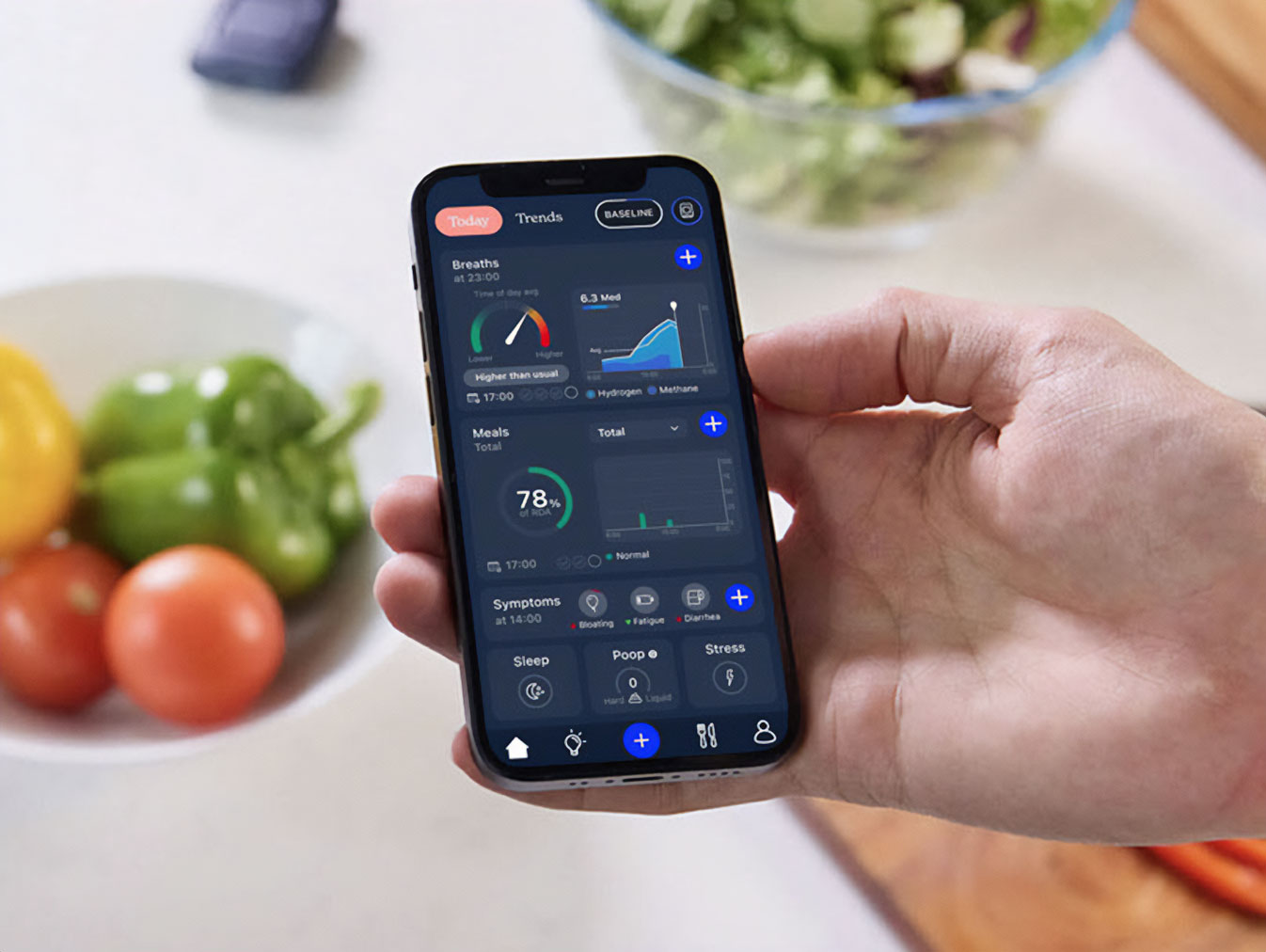
Thank you for purchasing FoodMarble AIRE! We have put together a step-by-step guide to help you get started with your new device. Choose your phone’s operating system below to get started.


Fully charge your device before its first use with the USB cable supplied.
Insert the smaller end of the cable into the USB charging port on the device, and the larger end into a USB power source.

Charging indicator: Red, Charging | Green, Fully Charged
Press and hold the power button for 2 seconds.

When the device is powered on, the sensors need to reach the correct temperature to perform an accurate gas measurement.
Small lights:
Device is warming up
Canal light:
Warm-up is complete and the device is ready for use
As with many tracking processes, the more consistent you are in tracking your data, the better the insights you will gain. Check out this video for an overview of the process and how to get best results.
To take a breath test, tap the large plus button on the home screen and select “Breath”. This video will show you the full process. Once prompted to take a breath test, here’s what we recommend for best results:
The app will calculate your Fermentation Score. Once you have completed a regular breath test, the device will power off.
Logging meals will help you better associate your breath test readings with possible problem foods, and also help you find the foods best suited to your digestive system.

Sleep and stress directly affect your digestion, so it’s important to log these also.
When you see increases in breath readings, that indicates what you ate or drank hasn’t been fully digested and is now being fermented in your gut by the bacteria that live there. After a breath test, the app will show you the meals you’ve logged. It will also show you how much of those hard-to-digest FODMAPs are in each meal, so you can link an increase in breath readings to something you ate or drank.
Everyone has a completely different mix of gut microbes. So even if you eat a meal high in a FODMAP, the gut microbes you have may not be able break down that undigested FODMAP through fermentation. For this reason, you won’t always have large amount of gas production in your gut after having some FODMAPs. Crucially, it depends on which FODMAPs you can tolerate.
It’s not “all or nothing”. Usually you can have at least some amount of any of the FODMAPs. You may find for a particular FODMAP, that the amount you can handle is very low but the core take-away is that you need to find what your tolerance level is for different FODMAPs.
Your digestive tract is effectively a long tube, so things that you eat will take some time to get through your stomach and reach the part of your gut that contains most of your gut microbes (your colon). This will vary from person to person and from meal to meal. Liquids generally move much faster and usually pass directly through the stomach, so you’ll see the effects of liquids faster. Different FODMAPs also ferment at different speeds. For example, simpler FODMAPs like fructose or lactose, can be broken down easily and are fermented more rapidly. Inulin, is a more complex carbohydrate, so it’s harder to break down. This means it may take longer for you to see a breath peak with inulin, but it can persist for a longer time.
Some peoples’ guts are a lot more sensitive to being inflated. The gases that are produced during fermentation can do this. Also water can be drawn into the gut by some FODMAPs, especially simpler FODMAPs like fructose and lactose. The combined effect of the gases and the water can inflate the gut, potentially causing pain and bloating.
For some people the gases that are produced during fermentation will be released faster from the body. However, for some, the gases will move more slowly. This can build up causing pain and bloating.
When you purchase the FoodMarble Program, you will receive the FODMAP testing kit with four sachets of FODMAPs: lactose, fructose, inulin, and sorbitol. These are specific food ingredients that are commonly hard to digest. They can pass through the stomach and small intestine without being fully digested. Once they reach the large intestine, bacteria feed on them, causing the release of certain gases. This process is called fermentation and can cause serious digestive disruption for some people.
Testing your fermentation levels with a FODMAP can help you figure out if that specific food component is potentially contributing to your digestive discomfort, though it isn’t required to start using your device. You can test after regular meals as soon as you receive the device and do your FODMAP tests later.
If you do have difficulty digesting a particular FODMAP, it’s best to schedule the challenge for a day that you don’t have activities planned in case it causes some temporary discomfort. Doing a FODMAP test as part of the 6-Week Discovery Plan requires some preparation. But don’t worry, the app will guide you through the process as you do it. You can also check the FAQ tab in the Challenges section of the app. These videos will explain the process for getting the most out of your FODMAP tests.
This video shows the steps needed to prepare for the FODMAP challenge.
This video shows the steps needed to prepare for the FODMAP challenge.
Some advice for how to look after your device and ensure it keeps working accurately:
Too many tests may harm the sensors in your device.
Don’t smoke cigarettes or e-cigarettes shortly before using the device.
Such as lubricants, hair, beauty and sun-care products. Silicone often appears as “dimethicone” or other ingredients ending in “cone.”
The mouthpiece is detachable and can be washed with soap and water.
We’re excited to get your feedback and to help you with any questions you may have about the device and app. Email us at hello@foodmarble.com to get in touch.
You can also check out our support page for more info.
Be the first to discover our latest articles, tips, and recipes

